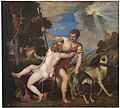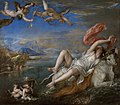
Tiziano Vecelli or Vecellio, Latinized as Titianus, hence known in English as Titian, was an Italian (Venetian) Renaissance painter of Lombard origin, considered the most important member of the 16th-century Venetian school. He was born in Pieve di Cadore, near Belluno. During his lifetime he was often called da Cadore, 'from Cadore', taken from his native region.

Annibale Carracci was an Italian painter and instructor, active in Bologna and later in Rome. Along with his brother and cousin, Annibale was one of the progenitors, if not founders of a leading strand of the Baroque style, borrowing from styles from both north and south of their native city, and aspiring for a return to classical monumentality, but adding a more vital dynamism. Painters working under Annibale at the gallery of the Palazzo Farnese would be highly influential in Roman painting for decades.

The Museo del Prado, officially known as Museo Nacional del Prado, is the main Spanish national art museum, located in central Madrid. It houses collections of European art, dating from the 12th century to the early 20th century, based on the former Spanish royal collection, and the single best collection of Spanish art. Founded as a museum of paintings and sculpture in 1819, it also contains important collections of other types of works. The numerous works by Francisco Goya, the single most extensively represented artist, as well as by Hieronymus Bosch, El Greco, Peter Paul Rubens, Titian, and Diego Velázquez, are some of the highlights of the collection. Velázquez and his keen eye and sensibility were also responsible for bringing much of the museum's fine collection of Italian masters to Spain, now one of the largest outside of Italy.

Paolo Caliari, known as Paolo Veronese, was an Italian Renaissance painter based in Venice, known for extremely large history paintings of religion and mythology, such as The Wedding at Cana (1563) and The Feast in the House of Levi (1573). Included with Titian, a generation older, and Tintoretto, a decade senior, Veronese is one of the "great trio that dominated Venetian painting of the cinquecento" and the Late Renaissance in the 16th century. Known as a supreme colorist, and after an early period with Mannerism, Paolo Veronese developed a naturalist style of painting, influenced by Titian.
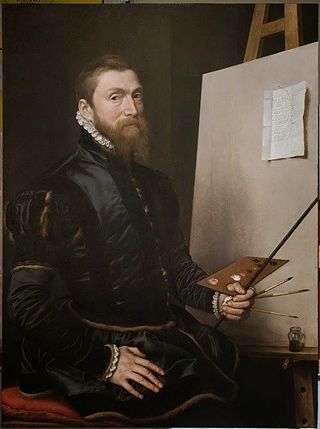
Anthonis Mor, also known as Anthonis Mor van Dashorst and Antonio Moro, was a Netherlandish portrait painter, much in demand by the courts of Europe. He has also been referred to as Antoon, Anthonius, Anthonis or Mor van Dashorst, and as Antonio Moro, António Mouro, Anthony More, etc., but signed most of his portraits as Anthonis Mor.
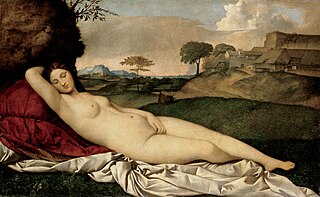
The Sleeping Venus, also known as the Dresden Venus, is a painting traditionally attributed to the Italian Renaissance painter Giorgione, although it has long been widely thought that Titian completed it after Giorgione's death in 1510. The landscape and sky are generally accepted to be mainly by Titian. In the 21st century, much scholarly opinion has shifted further, to see the nude figure of Venus as also painted by Titian, leaving Giorgione's contribution uncertain. It is in the Gemäldegalerie, Dresden. After World War II, the painting was briefly in possession of the Soviet Union.

Diana and Actaeon is a painting by the Italian Renaissance master Titian, finished in 1556–1559, and is considered amongst Titian's greatest works. It portrays the moment in which the hunter Actaeon bursts in where the goddess Diana and her nymphs are bathing. Diana is furious, and will turn Actaeon into a stag, who is then pursued and killed by his own hounds, a scene Titian later painted in his The Death of Actaeon.

Diana and Callisto is a painting completed between 1556 and 1559 by the Italian late Renaissance artist Titian. It portrays the moment in which the goddess Diana discovers that her maid Callisto has become pregnant by Jupiter. The painting was jointly purchased by the National Gallery and the Scottish National Gallery for £45 million in March 2012. Along with its companion painting Diana and Actaeon it is displayed on an alternating basis between London and Edinburgh. There is a later version by Titian and his workshop in the Kunsthistorisches Museum in Vienna.

The Death of Actaeon is a late work by the Italian Renaissance painter Titian, painted in oil on canvas from about 1559 to his death in 1576 and now in the National Gallery in London. It is very probably one of the two paintings the artist stated he had started and hopes to finish in a letter to their commissioner Philip II of Spain during June 1559. However, most of Titian's work on this painting possibly dates to the late 1560s, but with touches from the 1570s. Titian seems never to have resolved it to his satisfaction, and the painting apparently remained in his studio until his death in 1576. There has been considerable debate as to whether it is finished or not, as with other very late Titians, such as the Flaying of Marsyas, which unlike this has a signature, perhaps an indication of completion.
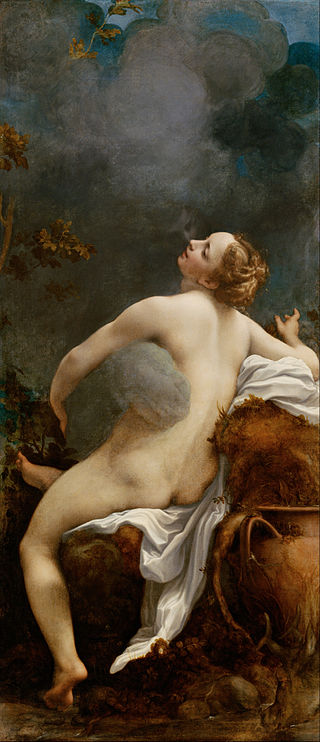
The Orleans Collection was a very important collection of over 500 paintings formed by Philippe II, Duke of Orléans, mostly acquired between about 1700 and his death in 1723. Apart from the great royal-become-national collections of Europe it is arguably the greatest private collection of Western art, especially Italian, ever assembled, and probably the most famous, helped by the fact that most of the collection has been accessible to the public since it was formed, whether in Paris, or subsequently in London, Edinburgh and elsewhere.

The Venetian painter Titian and his workshop made at least six versions of the same composition showing Danaë, painted between about 1544 and the 1560s. The scene is based on the mythological princess Danaë, as – very briefly – recounted by the Roman poet Ovid, and at greater length by Boccaccio. She was isolated in a bronze tower following a prophecy that her firstborn would eventually kill her father. Although aware of the consequences, Danaë was seduced and became pregnant by Zeus, who, inflamed by lust, descended from Mount Olympus to seduce her in the form of a shower of gold.

Venus and Adonis is a painting by the Italian late Mannerist artist Paolo Veronese, executed in the early 1580s, now in the Museo del Prado, in Madrid.

Salome, or possibly Judith with the Head of Holofernes, is an oil painting which is an early work by the Venetian painter of the late Renaissance, Titian. It is usually thought to represent Salome with the head of John the Baptist. It is usually dated to around 1515 and is now in the Doria Pamphilj Gallery in Rome. Like other paintings of this subject, it has sometimes been considered to represent Judith with the head of Holofernes, the other biblical incident found in art showing a female and a severed male head. Historically, the main figure has also been called Herodias, the mother of Salome.

The Portrait of Isabella of Portugal is an oil-on-canvas portrait of Isabella of Portugal, Holy Roman Empress by Titian dating to 1548. It was part of the Spanish royal collection and is now in the Museo del Prado in Madrid.

Venus and Musician refers to a series of paintings by the Venetian Renaissance painter Titian and his workshop.

Venus with a Mirror is a painting by Titian, now in the National Gallery of Art in Washington, DC, and it is considered to be one of the collection's highlights.
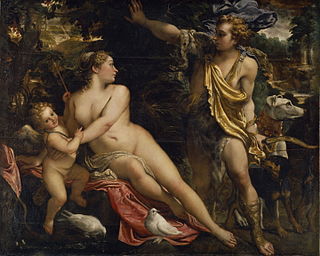
Venus, Adonis and Cupid is a painting created c. 1595 by Annibale Carracci. The painting is in the Museo del Prado, Madrid. Annibale Carracci was one of the most well known Italian Baroque painters of the seventeenth century. The Carracci brothers established an academy of art called Accademia degli Incamminati, which pioneered the development of Bolognese Painting. Annibale Carracci and Caravaggio were among the most influential artists of this century, who through their unique artistic styles led to the transition from Mannerist to Baroque. Annibale was born in Bologna in 1560 and died in Rome in 1609.
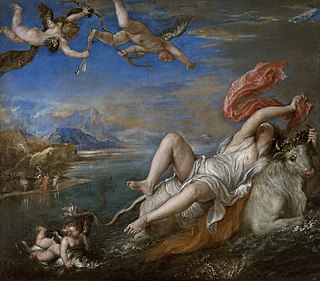
The Rape of Europa is a painting by the Venetian artist Titian, painted ca. 1560–1562. It is in the permanent collection of the Isabella Stewart Gardner Museum of Boston, Massachusetts. The oil-on-canvas painting measures 178 by 205 centimetres.
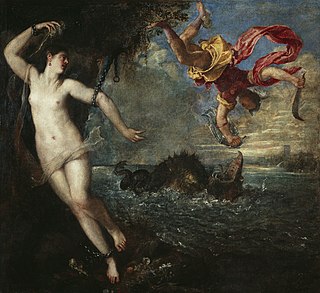
Perseus and Andromeda is a painting by the Italian Renaissance artist Titian, now in the Wallace Collection in London. It was painted in 1554–1556 as part of a series of mythological paintings called "poesie" ("poetry") intended for King Philip II of Spain. The paintings took subjects from the Roman poet Ovid's Metamorphoses, in this case Book IV, lines 663–752, and all featured female nudes.

The Pardo Venus is a painting by the Venetian artist Titian, completed in 1551 and now in the Louvre Museum. It is also known as Jupiter and Antiope, since it seems to show the story of Jupiter and Antiope from Book VI of the Metamorphoses. It is Titian's largest mythological painting, and was the first major mythological painting produced by the artist for Philip II of Spain. It was long kept in the Royal Palace of El Pardo near Madrid, hence its usual name; whether Venus is actually represented is uncertain. It later belonged to the English and French royal collections.












